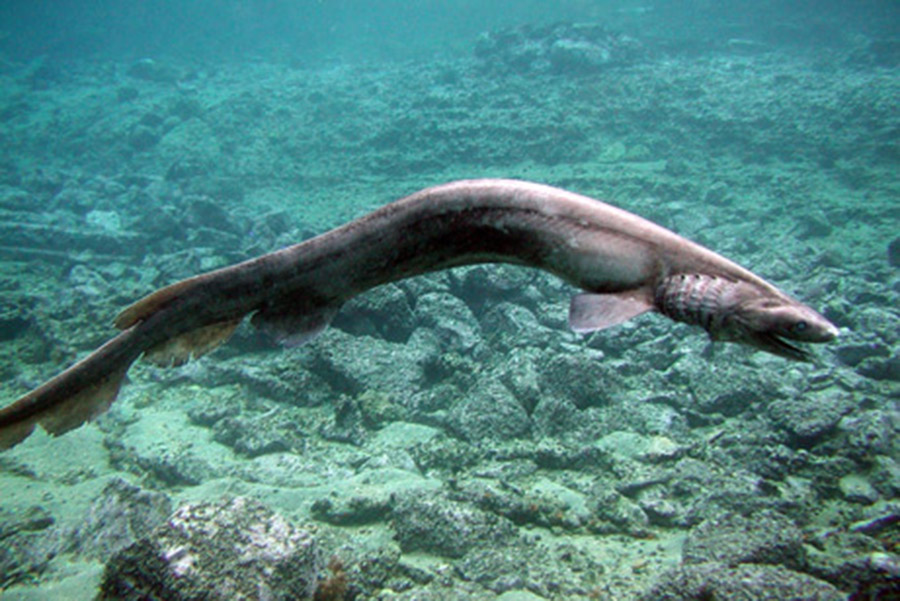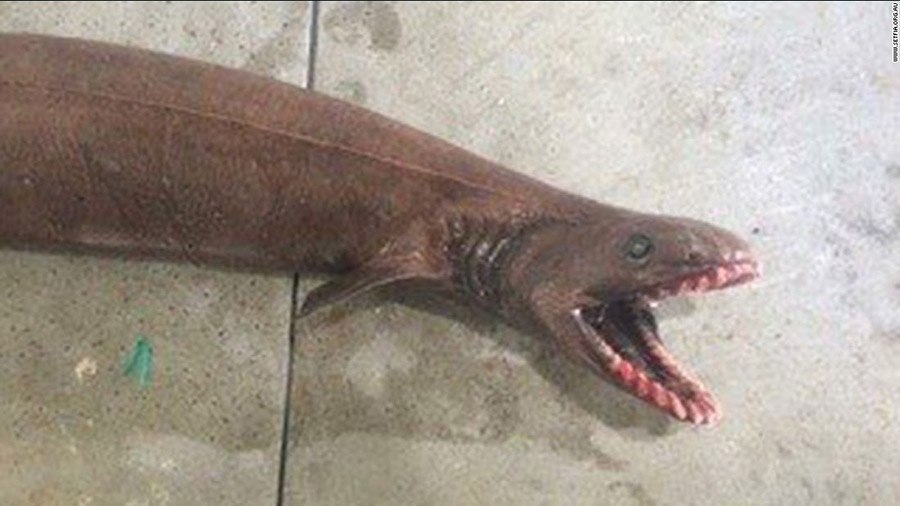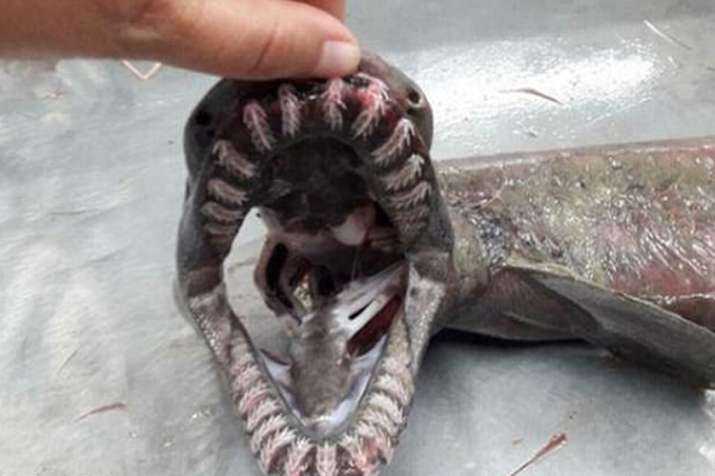https://www.morningticker.com/2017/11/scientists-make-terrifying-discovery-in-the-atlantic-ocean/
Scientists make terrifying discovery in the Atlantic Ocean
November 11, 2017 by Dan Taylor Leave a Comment

Scientists have come across a live frilled shark, a very rare creature that has remained essentially unchanged for 80 million years.
Scientists have made an astonishing discovery off the coast of Portugal, finding a “living fossil” that is super-rare because of its life deep under the ocean. The frightening species known as the frilled shark was found off the Algarve coast during a research project by the European Union, which is trying to minimize unwanted catches in commercial fishing.
It’s a scary looking creature, but totally harmless to humans, and in fact it is rare for us to even come across one because they live between 390 and 4,200 feet below the seat. It looks probably the same as it during the Cretaceous Period when dinosaurs roamed the Earth.
And it was a pretty big fish, although not the largest ever recorded coming in at five feet long. It is so named for its odd gills that stretch along its throat and have frills on the outside of them.
The following is an excerpt from Wikipedia on the frilled shark.
The frilled shark (Chlamydoselachus anguineus) is one of two extant species of shark in the family Chlamydoselachidae, with a wide but patchy distribution in the Atlantic and Pacific Oceans. This species is found over the outer continental shelf and upper continental slope, generally near the bottom, though there is evidence of substantial upward movements. It has been caught as deep as 1,570 m (5,150 ft), although it is uncommon below 1,200 m (3,900 ft).[2] In Suruga Bay, Japan, it is most common at depths of 50–200 m (160–660 ft). Exhibiting several “primitive” features, the frilled shark has often been termed a “living fossil”. It reaches a length of 2 m (6.6 ft) and has a dark brown, eel-like body with the dorsal, pelvic, and anal fins placed far back. Its common name comes from the frilly or fringed appearance of its six pairs of gill slits, with the first pair meeting across the throat.
Seldom observed, the frilled shark may capture prey by bending its body and lunging forward like a snake. The long, extremely flexible jaws enable it to swallow prey whole, while its many rows of small, needle-like teeth make it difficult for the prey to escape. It feeds mainly on cephalopods, leavened by bony fishes and other sharks. This species is aplacental viviparous: the embryos emerge from their egg capsules inside the mother’s uterus, where they survive primarily on yolk. The gestation period may be as long as three and a half years, the longest of any vertebrate. Litter sizes vary from two to fifteen, and there is no distinct breeding season. Frilled sharks are occasional bycatch in commercial fisheries, but have little economic value.
Rather uncommon, the frilled shark has been recorded from a number of widely scattered locations in the Atlantic and Pacific Oceans. In the eastern Atlantic, it occurs off northern Norway, northern Scotland, and western Ireland, from France to Morocco including Madeira, and off Mauritania.[12] In the central Atlantic, it has been caught at several locations along the Mid-Atlantic Ridge, from north of the Azores to the Rio Grande Rise off southern Brazil, as well as over the Vavilov Ridge off West Africa. In the western Atlantic, it has been reported from waters off New England, Georgia, and Suriname.[13][14][15] In the western Pacific, it is known from southeastern Honshu, Japan, to Taiwan, off New South Wales and Tasmania in Australia, and around New Zealand. In the central and eastern Pacific, it has been found off Hawaii, California, and northern Chile.[1][12] The frilled sharks off southern Africa were described as a different species, C. africana, in 2009.[15]
The frilled shark inhabits the outer continental shelf and upper to middle continental slope, seeming to favor upwellings and other biologically productive areas.[5] Though it has been caught from a depth of 1,570 m (5,150 ft), it usually does not occur deeper than 1,000 m (3,300 ft).[1][6] In Suruga Bay, it is most common at a depth of 50–200 m (160–660 ft), except from August to November when the temperature at the 100 m (330 ft) water layer exceeds 15 °C (59 °F) and the sharks shift into deeper water.[16][17] On rare occasions, this species has been seen at the surface.[12] The frilled shark is usually found close to the bottom, with one individual observed swimming over an area of small sand dunes.[1][13] However, its diet suggests that it does make substantial forays upward into open water.[18] This species may make vertical migrations, approaching the surface at night to feed.[5] There is spatial segregation by size and reproductive condition.
Rather uncommon, the frilled shark has been recorded from a number of widely scattered locations in the Atlantic and Pacific Oceans. In the eastern Atlantic, it occurs off northern Norway, northern Scotland, and western Ireland, from France to Morocco including Madeira, and off Mauritania.[12] In the central Atlantic, it has been caught at several locations along the Mid-Atlantic Ridge, from north of the Azores to the Rio Grande Rise off southern Brazil, as well as over the Vavilov Ridge off West Africa. In the western Atlantic, it has been reported from waters off New England, Georgia, and Suriname.[13][14][15] In the western Pacific, it is known from southeastern Honshu, Japan, to Taiwan, off New South Wales and Tasmania in Australia, and around New Zealand. In the central and eastern Pacific, it has been found off Hawaii, California, and northern Chile.[1][12] The frilled sharks off southern Africa were described as a different species, C. africana, in 2009.[15]
The frilled shark inhabits the outer continental shelf and upper to middle continental slope, seeming to favor upwellings and other biologically productive areas.[5] Though it has been caught from a depth of 1,570 m (5,150 ft), it usually does not occur deeper than 1,000 m (3,300 ft).[1][6] In Suruga Bay, it is most common at a depth of 50–200 m (160–660 ft), except from August to November when the temperature at the 100 m (330 ft) water layer exceeds 15 °C (59 °F) and the sharks shift into deeper water.[16][17] On rare occasions, this species has been seen at the surface.[12] The frilled shark is usually found close to the bottom, with one individual observed swimming over an area of small sand dunes.[1][13] However, its diet suggests that it does make substantial forays upward into open water.[18] This species may make vertical migrations, approaching the surface at night to feed.[5] There is spatial segregation by size and reproductive condition.
Like This Post? ... Then Like Our Page
Scientists make terrifying discovery in the Atlantic Ocean
November 11, 2017 by Dan Taylor Leave a Comment

Scientists have come across a live frilled shark, a very rare creature that has remained essentially unchanged for 80 million years.
Scientists have made an astonishing discovery off the coast of Portugal, finding a “living fossil” that is super-rare because of its life deep under the ocean. The frightening species known as the frilled shark was found off the Algarve coast during a research project by the European Union, which is trying to minimize unwanted catches in commercial fishing.
It’s a scary looking creature, but totally harmless to humans, and in fact it is rare for us to even come across one because they live between 390 and 4,200 feet below the seat. It looks probably the same as it during the Cretaceous Period when dinosaurs roamed the Earth.
And it was a pretty big fish, although not the largest ever recorded coming in at five feet long. It is so named for its odd gills that stretch along its throat and have frills on the outside of them.
The following is an excerpt from Wikipedia on the frilled shark.
The frilled shark (Chlamydoselachus anguineus) is one of two extant species of shark in the family Chlamydoselachidae, with a wide but patchy distribution in the Atlantic and Pacific Oceans. This species is found over the outer continental shelf and upper continental slope, generally near the bottom, though there is evidence of substantial upward movements. It has been caught as deep as 1,570 m (5,150 ft), although it is uncommon below 1,200 m (3,900 ft).[2] In Suruga Bay, Japan, it is most common at depths of 50–200 m (160–660 ft). Exhibiting several “primitive” features, the frilled shark has often been termed a “living fossil”. It reaches a length of 2 m (6.6 ft) and has a dark brown, eel-like body with the dorsal, pelvic, and anal fins placed far back. Its common name comes from the frilly or fringed appearance of its six pairs of gill slits, with the first pair meeting across the throat.
Seldom observed, the frilled shark may capture prey by bending its body and lunging forward like a snake. The long, extremely flexible jaws enable it to swallow prey whole, while its many rows of small, needle-like teeth make it difficult for the prey to escape. It feeds mainly on cephalopods, leavened by bony fishes and other sharks. This species is aplacental viviparous: the embryos emerge from their egg capsules inside the mother’s uterus, where they survive primarily on yolk. The gestation period may be as long as three and a half years, the longest of any vertebrate. Litter sizes vary from two to fifteen, and there is no distinct breeding season. Frilled sharks are occasional bycatch in commercial fisheries, but have little economic value.
Rather uncommon, the frilled shark has been recorded from a number of widely scattered locations in the Atlantic and Pacific Oceans. In the eastern Atlantic, it occurs off northern Norway, northern Scotland, and western Ireland, from France to Morocco including Madeira, and off Mauritania.[12] In the central Atlantic, it has been caught at several locations along the Mid-Atlantic Ridge, from north of the Azores to the Rio Grande Rise off southern Brazil, as well as over the Vavilov Ridge off West Africa. In the western Atlantic, it has been reported from waters off New England, Georgia, and Suriname.[13][14][15] In the western Pacific, it is known from southeastern Honshu, Japan, to Taiwan, off New South Wales and Tasmania in Australia, and around New Zealand. In the central and eastern Pacific, it has been found off Hawaii, California, and northern Chile.[1][12] The frilled sharks off southern Africa were described as a different species, C. africana, in 2009.[15]
The frilled shark inhabits the outer continental shelf and upper to middle continental slope, seeming to favor upwellings and other biologically productive areas.[5] Though it has been caught from a depth of 1,570 m (5,150 ft), it usually does not occur deeper than 1,000 m (3,300 ft).[1][6] In Suruga Bay, it is most common at a depth of 50–200 m (160–660 ft), except from August to November when the temperature at the 100 m (330 ft) water layer exceeds 15 °C (59 °F) and the sharks shift into deeper water.[16][17] On rare occasions, this species has been seen at the surface.[12] The frilled shark is usually found close to the bottom, with one individual observed swimming over an area of small sand dunes.[1][13] However, its diet suggests that it does make substantial forays upward into open water.[18] This species may make vertical migrations, approaching the surface at night to feed.[5] There is spatial segregation by size and reproductive condition.
Rather uncommon, the frilled shark has been recorded from a number of widely scattered locations in the Atlantic and Pacific Oceans. In the eastern Atlantic, it occurs off northern Norway, northern Scotland, and western Ireland, from France to Morocco including Madeira, and off Mauritania.[12] In the central Atlantic, it has been caught at several locations along the Mid-Atlantic Ridge, from north of the Azores to the Rio Grande Rise off southern Brazil, as well as over the Vavilov Ridge off West Africa. In the western Atlantic, it has been reported from waters off New England, Georgia, and Suriname.[13][14][15] In the western Pacific, it is known from southeastern Honshu, Japan, to Taiwan, off New South Wales and Tasmania in Australia, and around New Zealand. In the central and eastern Pacific, it has been found off Hawaii, California, and northern Chile.[1][12] The frilled sharks off southern Africa were described as a different species, C. africana, in 2009.[15]
The frilled shark inhabits the outer continental shelf and upper to middle continental slope, seeming to favor upwellings and other biologically productive areas.[5] Though it has been caught from a depth of 1,570 m (5,150 ft), it usually does not occur deeper than 1,000 m (3,300 ft).[1][6] In Suruga Bay, it is most common at a depth of 50–200 m (160–660 ft), except from August to November when the temperature at the 100 m (330 ft) water layer exceeds 15 °C (59 °F) and the sharks shift into deeper water.[16][17] On rare occasions, this species has been seen at the surface.[12] The frilled shark is usually found close to the bottom, with one individual observed swimming over an area of small sand dunes.[1][13] However, its diet suggests that it does make substantial forays upward into open water.[18] This species may make vertical migrations, approaching the surface at night to feed.[5] There is spatial segregation by size and reproductive condition.
Like This Post? ... Then Like Our Page





